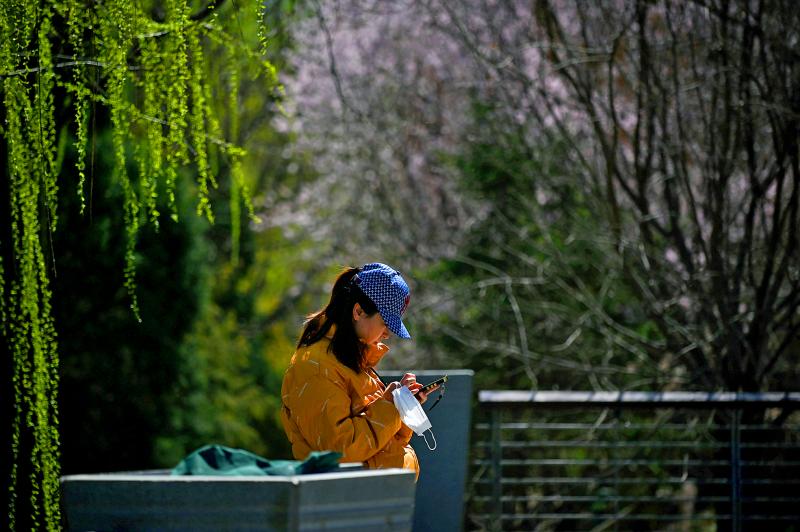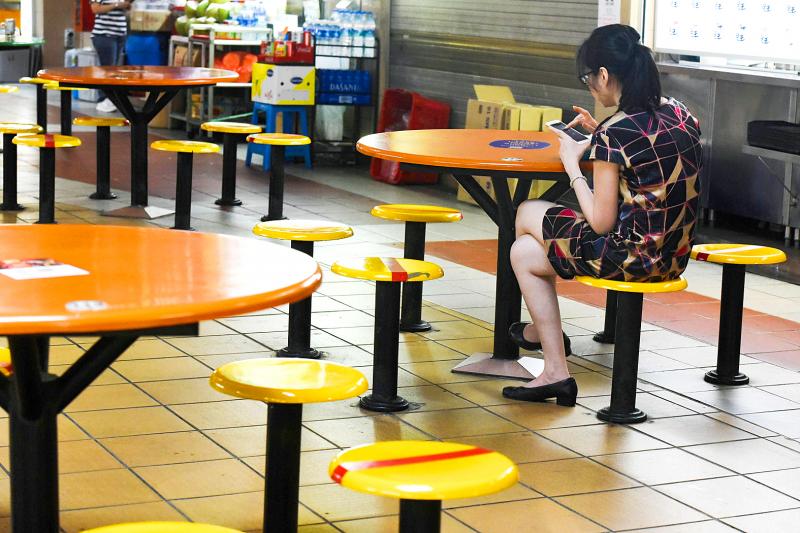With governments clamping down on social interactions to contain the coronavirus spread, dating sites are discouraging dates and asking users to get to know each other virtually instead.
“We don’t know who needs to hear this, but now is NOT the time to go out with your date to a bar,” leading match-maker OkCupid tweeted on Monday. “FaceTime, Skype, call, text, call, message on our app.... all very romantic right now,” it added.
Dating sites contacted by AFP refused to divulge their traffic since COVID-19 starting shutting down US cities this week but it appears their usage is far from slowing.

Photo: AFP
Even if some academics would like them to suspend their activities entirely.
“It’s time to shut down Tinder and all online dating services,” tweeted US writer Matt Stoller. “No more Internet-enabled interactions among random people until the #coronavirus crisis has passed,” he added.
Joking about the coronavirus has become popular on dating sites, although not necessarily effective at endearing matches to each other.

Photo: AFP
“If someone seems like they’re not taking the crisis seriously or they’re making fun of it for me personally that’s a turnoff,” said comedian and author Lane Moore.
She helped created the show Tinder Live, in which she interacts with matches in real time, and thinks coronavirus could be an “opportunity” for people to bond.
“I’m talking to a guy right now who I met on Tinder Live and we’re both talking about how this coronavirus COVID-19 stuff is impacting our lives so that can be a good way to know somebody,” she said.

Photo: AFP
Moore, from New York, says many of the men she meets on Tinder want to cut the conversation short and jump straight to meeting in the flesh.
She thinks it’s a good thing that now men are being forced to chat more first.
‘ONE-WORD ANSWERS’
“That’s something that women have always wanted because it’s an opportunity to meet someone you like the first time but also try to make sure that they’re safe,” Moore said.
The dating site Coffee Meets Bagel (CMB) is proposing several different ideas for remote interactions, including an online video game date.
“This is going to be important for us to think outside the box in crazy times like this,” said CEO Dawoon Kang.
CMB is also organizing an online group discussion, which it has never done before.
Yale University student Ileana Valdez and five friends spent just a few hours setting up a dating site for students whose classes have been canceled and campuses are deserted.
The site, OKZoomer, a nod to the popular expression “Ok boomer” which millennials use to refer to older people, picked up 6,500 users in less than a week, according to Valdez.
“Social distancing allows us to focus on conversations and building up existing and new relationships,” the computer science student said.
She feels that the big dating apps are focused on “hookups,” and argues that OKZoomer sets the ground for “meaningful relationships.”
For example OKZoomer’s algorithm does not prioritize proximity, unlike most major dating sites.
Other sites are emerging too, such as “Quarantine Together,” whose slogan is “Get close even when you can’t be close.”
Moore, the comedian, isn’t convinced that the new coronavirus will spark a dating revolution though.
“I can imagine that once all of this settles down the men who don’t really want to be having a conversation will probably go back to one-word answers.”

June 23 to June 29 After capturing the walled city of Hsinchu on June 22, 1895, the Japanese hoped to quickly push south and seize control of Taiwan’s entire west coast — but their advance was stalled for more than a month. Not only did local Hakka fighters continue to cause them headaches, resistance forces even attempted to retake the city three times. “We had planned to occupy Anping (Tainan) and Takao (Kaohsiung) as soon as possible, but ever since we took Hsinchu, nearby bandits proclaiming to be ‘righteous people’ (義民) have been destroying train tracks and electrical cables, and gathering in villages

Swooping low over the banks of a Nile River tributary, an aid flight run by retired American military officers released a stream of food-stuffed sacks over a town emptied by fighting in South Sudan, a country wracked by conflict. Last week’s air drop was the latest in a controversial development — private contracting firms led by former US intelligence officers and military veterans delivering aid to some of the world’s deadliest conflict zones, in operations organized with governments that are combatants in the conflicts. The moves are roiling the global aid community, which warns of a more militarized, politicized and profit-seeking trend

The wide-screen spectacle of Formula One gets a gleaming, rip-roaring workout in Joseph Kosinski’s F1, a fine-tuned machine of a movie that, in its most riveting racing scenes, approaches a kind of high-speed splendor. Kosinski, who last endeavored to put moviegoers in the seat of a fighter jet in Top Gun: Maverick, has moved to the open cockpits of Formula One with much the same affection, if not outright need, for speed. A lot of the same team is back. Jerry Bruckheimer produces. Ehren Kruger, a co-writer on Maverick, takes sole credit here. Hans Zimmer, a co-composer previously, supplies the thumping

Dr. Y. Tony Yang, Associate Dean of Health Policy and Population Science at George Washington University, argued last week in a piece for the Taipei Times about former president Ma Ying-jeou (馬英九) leading a student delegation to the People’s Republic of China (PRC) that, “The real question is not whether Ma’s visit helps or hurts Taiwan — it is why Taiwan lacks a sophisticated, multi-track approach to one of the most complex geopolitical relationships in the world” (“Ma’s Visit, DPP’s Blind Spot,” June 18, page 8). Yang contends that the Democratic Progressive Party (DPP) has a blind spot: “By treating any